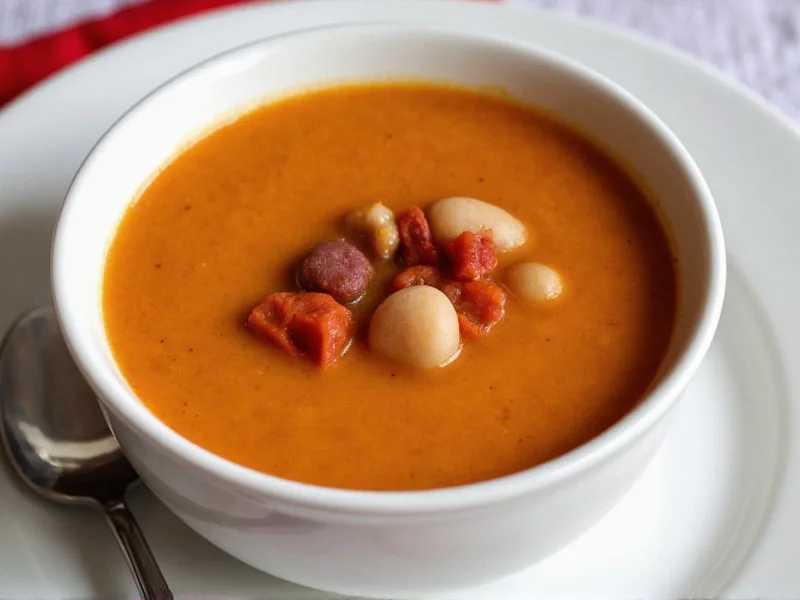Creating the perfect three bean soup requires understanding both technique and ingredient synergy. This comprehensive guide explores the culinary science behind balancing flavors and textures while maximizing nutritional benefits. Unlike simplified recipes that merely combine canned beans, authentic three bean soup involves thoughtful layering of ingredients and proper cooking techniques to develop complex flavors.
The Essential Bean Trio
While variations exist, the classic three bean combination creates a nutritional and textural balance:
| Bean Type | Flavor Profile | Texture | Nutritional Highlight |
|---|---|---|---|
| Kidney Beans | Earthy, robust | Firm, meaty | High in iron and folate |
| Black Beans | Sweet, slightly smoky | Creamy interior | Rich in antioxidants |
| Cannellini Beans | Mild, nutty | Buttery, smooth | Excellent source of magnesium |
Building Flavor Foundations
Professional chefs emphasize the "holy trinity" of mirepoix (onions, celery, and carrots) as the flavor base for exceptional three bean soup. Sauté these vegetables in olive oil until caramelized—this Maillard reaction creates hundreds of flavor compounds that canned broth alone cannot provide. For depth, add tomato paste and cook until it darkens slightly, then deglaze with a splash of dry white wine or vinegar to lift the fond from the pan.
Step-by-Step Preparation Guide
Follow this method for restaurant-quality results:
- Soak dried beans overnight (or use quick-soak method) for optimal texture—canned beans often become mushy
- Sauté aromatics until deeply caramelized (15-20 minutes on medium-low heat)
- Add herbs early—tie thyme, rosemary, and bay leaves in cheesecloth for easy removal
- Simmer beans separately from vegetables to prevent overcooking
- Combine components during final 30-minute simmer to meld flavors
- Finish with acid—a splash of lemon juice or vinegar brightens flavors
Nutritional Advantages
Three bean soup exemplifies nutritional synergy. The combination provides complete protein through complementary amino acids, while the high fiber content (12-15g per serving) regulates blood sugar more effectively than single-bean preparations. Registered dietitians note that the soluble fiber in beans binds to cholesterol during digestion, potentially reducing LDL levels by 5-10% with regular consumption. For optimal nutrient absorption, include a vitamin C source like tomatoes or bell peppers to enhance iron bioavailability from the beans.
Common Mistakes to Avoid
Even experienced cooks make these three bean soup errors:
- Adding salt too early—delay salting until beans are nearly tender to prevent tough skins
- Over-blending—purée only 1/3 of the soup for ideal texture contrast
- Using old beans—beans stored beyond 12 months won't soften properly
- Skipping acid at the end—this crucial step balances richness
Variations for Dietary Needs
Adapt this versatile recipe for specific requirements:
- Smoky Southwest: Add chipotle peppers and cumin, serve with avocado
- Mediterranean: Incorporate oregano, lemon zest, and Kalamata olives
- Protein Boost: Stir in 1/2 cup quinoa during final simmer
- Instant Pot Method: Cook soaked beans at high pressure for 8 minutes
Storage and Reheating Best Practices
Three bean soup improves in flavor after 24 hours as ingredients meld. Store in airtight containers:
- Refrigeration: Keeps 5-7 days—add broth when reheating as beans absorb liquid
- Freezing: Portion in freezer bags (lay flat for space efficiency) up to 6 months
- Reheating: Warm gradually over medium-low heat to prevent bean breakage
Frequently Asked Questions
Can I make three bean soup without soaking beans overnight?
Yes, use the quick-soak method: Cover dried beans with 3 inches of water, bring to boil for 2 minutes, then remove from heat and let stand covered for 1 hour. Drain and proceed with recipe. Note that texture won't be quite as perfect as with overnight soaking.
Why do my beans remain hard even after long cooking?
Hard beans typically indicate one of three issues: 1) Using beans older than 12 months (they lose moisture-retention ability), 2) Cooking in hard water (minerals interfere with softening), or 3) Adding acidic ingredients too early. Try adding 1/4 teaspoon baking soda to the soaking water to help soften older beans.
How can I thicken three bean soup without compromising texture?
Remove 1-2 cups of soup (primarily broth with some beans), blend until smooth, then return to the pot. This technique thickens while maintaining whole bean integrity. Alternatively, mash a few beans against the pot side with a wooden spoon during the final simmer.
What's the best way to freeze three bean soup for meal prep?
Portion cooled soup into freezer bags, removing as much air as possible. Lay flat in the freezer for space efficiency. For best results, freeze without potatoes or pasta (add these fresh when reheating). Thaw overnight in the refrigerator and reheat gently with a splash of broth.
Can I make three bean soup in a slow cooker?
Absolutely. Sauté aromatics first, then transfer to slow cooker with pre-soaked beans and broth. Cook on low for 6-8 hours. Add delicate vegetables like zucchini during the last hour. Avoid adding acidic ingredients until the final hour to prevent toughening beans.











 浙公网安备
33010002000092号
浙公网安备
33010002000092号 浙B2-20120091-4
浙B2-20120091-4